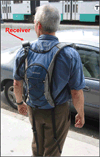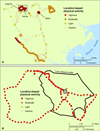The built environment and location-based physical activity
- PMID: 20307812
- PMCID: PMC3568665
- DOI: 10.1016/j.amepre.2009.12.032
The built environment and location-based physical activity
Abstract
Background: Studies of the built environment and physical activity have implicitly assumed that a substantial amount of activity occurs near home, but in fact the location is unknown.
Purpose: This study aims to examine associations between built environment variables within home and work buffers and moderate-to-vigorous physical activity (MVPA) occurring within these locations.
Methods: Adults (n=148) from Massachusetts wore an accelerometer and GPS unit for up to 4 days. Levels of MVPA were quantified within 50-m and 1-km home and work buffers. Multiple regression models were used to examine associations between five objective built environment variables within 1-km home and work buffers (intersection density, land use mix, population and housing unit density, vegetation index) and MVPA within those areas.
Results: The mean daily minutes of MVPA accumulated in all locations=61.1+/-32.8, whereas duration within the 1-km home buffers=14.0+/-16.4 minutes. Intersection density, land use mix, and population and housing unit density within 1-km home buffers were positively associated with MVPA in the buffer, whereas a vegetation index showed an inverse relationship (all p<0.05). None of these variables showed associations with total MVPA. Within 1 km of work, only population and housing unit density were significantly associated with MVPA within the buffer.
Conclusions: Findings are consistent with studies showing that certain attributes of the built environment around homes are positively related to physical activity, but in this case only when the outcome was location-based. Simultaneous accelerometer-GPS monitoring shows promise as a method to improve understanding of how the built environment influences physical activity behaviors by allowing activity to be quantified in a range of physical contexts and thereby provide a more explicit link between physical activity outcomes and built environment exposures.
2010 American Journal of Preventive Medicine. Published by Elsevier Inc. All rights reserved.
Figures
Similar articles
-
Accelerometer and GPS Data to Analyze Built Environments and Physical Activity.Res Q Exerc Sport. 2019 Sep;90(3):395-402. doi: 10.1080/02701367.2019.1609649. Epub 2019 Jun 14. Res Q Exerc Sport. 2019. PMID: 31199713 Free PMC article.
-
Do associations between objectively-assessed physical activity and neighbourhood environment attributes vary by time of the day and day of the week? IPEN adult study.Int J Behav Nutr Phys Act. 2017 Mar 20;14(1):34. doi: 10.1186/s12966-017-0493-z. Int J Behav Nutr Phys Act. 2017. PMID: 28320422 Free PMC article.
-
Characteristics of the built environment in relation to objectively measured physical activity among Mexican adults, 2011.Prev Chronic Dis. 2014 Aug 28;11:E147. doi: 10.5888/pcd11.140047. Prev Chronic Dis. 2014. PMID: 25167092 Free PMC article.
-
Evidence synthesis - Where are children and adults physically active and sedentary? - a rapid review of location-based studies.Health Promot Chronic Dis Prev Can. 2019 Mar;39(3):67-103. doi: 10.24095/hpcdp.39.3.01. Health Promot Chronic Dis Prev Can. 2019. PMID: 30869472 Free PMC article. Review.
-
Combining GPS, GIS, and accelerometry to explore the physical activity and environment relationship in children and young people - a review.Int J Behav Nutr Phys Act. 2014 Sep 13;11:93. doi: 10.1186/s12966-014-0093-0. Int J Behav Nutr Phys Act. 2014. PMID: 25356782 Free PMC article. Review.
Cited by
-
Urban built environment configuration and psychological distress in older men: results from the Caerphilly study.BMC Public Health. 2013 Jul 30;13:695. doi: 10.1186/1471-2458-13-695. BMC Public Health. 2013. PMID: 23898839 Free PMC article.
-
Does the social environment moderate associations of the built environment with Latinas' objectively-measured neighborhood outdoor physical activity?Prev Med Rep. 2016 Oct 19;4:551-557. doi: 10.1016/j.pmedr.2016.10.006. eCollection 2016 Dec. Prev Med Rep. 2016. PMID: 27818913 Free PMC article.
-
The built environment predicts observed physical activity.Front Public Health. 2014 May 20;2:52. doi: 10.3389/fpubh.2014.00052. eCollection 2014. Front Public Health. 2014. PMID: 24904916 Free PMC article.
-
Home and work neighbourhood environments in relation to body mass index: the Multi-Ethnic Study of Atherosclerosis (MESA).J Epidemiol Community Health. 2013 Oct;67(10):846-53. doi: 10.1136/jech-2013-202682. Epub 2013 Jul 18. J Epidemiol Community Health. 2013. PMID: 23868527 Free PMC article.
-
The association between spatial access to physical activity facilities within home and workplace neighborhoods and time spent on physical activities: evidence from Guangzhou, China.Int J Health Geogr. 2020 Jun 20;19(1):22. doi: 10.1186/s12942-020-00216-2. Int J Health Geogr. 2020. PMID: 32563255 Free PMC article.
References
-
- King AC. Community and public health approaches to the promotion of physical activity. Med Sci Sports Exerc. 1994;26(11):1405–1412. - PubMed
-
- King AC, Jeffery RW, Fridinger F, et al. Environmental and policy approaches to cardiovascular disease prevention through physical activity: issues and opportunities. Health Educ Q. 1995;22(4):499–511. - PubMed
-
- Ewing R, Cervero R. Travel and the built environment: a synthesis. Transportation Research Record. 2001;1780:87–113.
-
- Humpel N, Owen N, Leslie E. Environmental factors associated with adults' participation in physical activity: a review. Am J Prev Med. 2002;22(3):188–199. - PubMed
Publication types
MeSH terms
Grants and funding
LinkOut - more resources
Full Text Sources



